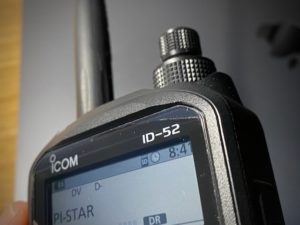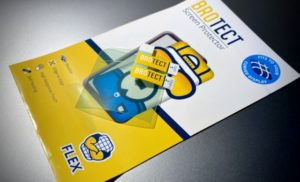Since buying the ID-52 I haven’t been using it much outside of the shack because I’ve not been able to find a suitable screen protector, which is pretty much the first accessory that I add to any portable toy with a display. Especially when that display marks as easily as it does on Icom’s latest greatest handheld – minor scratches are already visible after 6 weeks of indoor use when all I’ve done is wipe off the occasional fingerprint with a clean microfibre cloth. But I digress.
Close, but no Cigar
The challenge in finding a good screen protector isn’t so much that the product is new or that there isn’t enough choice, it’s more to do with that strangely curved screen: a gentle Y-axis curve is compounded by a slightly more pronounced X-axis curve near the top of the display, which means that a protection film needs to bend simultaneously in two directions while also sticking evenly to the screen. That’s a pretty tall order, and the two films that I’ve tried so far (one made from thin glass, and one from plastic) have both started to peel off at the top within a couple of hours, allowing debris particles to enter the gap and get stuck on the underside of the film, where they’re then pressed against the screen. Not ideal.
And the Winner is …
This morning I received a replacement film from protectionfilms24.com in Germany, having previously given them feedback on the Brotect AirGlass product which didn’t work out, and I must say that I’m very impressed so far. The replacement isn’t made from AirGlass or from any other material I’ve previously encountered as a screen protector. With the backing in place on both sides it feels kind of rubbery, and although it’s shipped in a flat envelope it retains any curve that you apply to it when you bend it with your fingers.
The backing is removed in three steps, where the first peel gives you enough of a strip to position the film on the screen, the second peel uncovers the rest of the film for application now that it’s positioned, and the third peel removes a protective layer from the front of the film to reveal a glossy finish that doesn’t feel rubbery at all, but doesn’t feel like glass either. During application you can see why the initial backing is removed in two stages, because the film itself feels very flexible and the adhesive unusually strong, which would make it tricky to fix in one go and trickier still to re-align. Doing it in stages presents no problem at all, but if I were to be picky I’d prefer the first stage to be along the base of the screen rather than at the top, because it’s that first stage which is responsible for good alignment, so using the longest edge as your datum is a no-brainer for me. I’d also provide a margin of error by making the film fractionally smaller. Right now it’s exactly the same size as the screen underneath, and if you’re a fraction of a millimetre out with the initial alignment (using the screen’s shortest edge) then that translates to a greater error at the opposite end, where you’ve now got some overhang that may or may not nag at your OCD.
Finally, the material from which this film is constructed claims to be self-healing, and after scoring the surface gently with a fingernail you can indeed watch it ‘repair’ itself over the course of several minutes. That’s a great attribute for a screen protector which can’t be made from glass because it needs to adhere to a curved display, and I congratulate the guys over at Brotect for coming up with such a cool solution.


